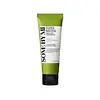What's inside
What's inside
 Key Ingredients
Key Ingredients

 Benefits
Benefits

 Concerns
Concerns

 Ingredients Side-by-side
Ingredients Side-by-side

Camellia Sinensis Leaf Water 62%
MaskingGlycerin
HumectantWater
Skin ConditioningPotassium Cocoyl Glycinate
Lauryl Glucoside
CleansingCoco-Glucoside
CleansingAcrylates Copolymer
Sodium Cocoyl Isethionate
Cleansing1,2-Hexanediol
Skin ConditioningSalix Alba Bark Water
AstringentSalix Alba Bark Extract
AstringentCentella Asiatica Extract
CleansingCentella Asiatica Leaf Extract
Skin ConditioningMelia Azadirachta Leaf Extract
Skin ConditioningMelia Azadirachta Flower Extract
Skin ConditioningCalamine
AbsorbentCamellia Sinensis Leaf Powder
ExfoliatingMelaleuca Alternifolia Leaf Powder
AbrasiveButylene Glycol
HumectantSodium Hyaluronate
HumectantAllantoin
Skin ConditioningMadecassic Acid
Skin ConditioningAsiaticoside
AntioxidantAsiatic Acid
Skin ConditioningMadecassoside
AntioxidantCocos Nucifera Oil
MaskingCoco-Caprylate/Caprate
EmollientCaprylyl Glycol
EmollientGlyceryl Undecylenate
EmollientPolyglyceryl-10 Myristate
Skin ConditioningPotassium Cetyl Phosphate
EmulsifyingLauric Acid
CleansingMannan
Lactobionic Acid
BufferingCitric Acid
BufferingTriethoxycaprylylsilane
Methylpropanediol
SolventBenzyl Glycol
SolventEthylhexylglycerin
Skin ConditioningRaspberry Ketone
MaskingParfum
MaskingCamellia Sinensis Leaf Water 62%, Glycerin, Water, Potassium Cocoyl Glycinate, Lauryl Glucoside, Coco-Glucoside, Acrylates Copolymer, Sodium Cocoyl Isethionate, 1,2-Hexanediol, Salix Alba Bark Water, Salix Alba Bark Extract, Centella Asiatica Extract, Centella Asiatica Leaf Extract, Melia Azadirachta Leaf Extract, Melia Azadirachta Flower Extract, Calamine, Camellia Sinensis Leaf Powder, Melaleuca Alternifolia Leaf Powder, Butylene Glycol, Sodium Hyaluronate, Allantoin, Madecassic Acid, Asiaticoside, Asiatic Acid, Madecassoside, Cocos Nucifera Oil, Coco-Caprylate/Caprate, Caprylyl Glycol, Glyceryl Undecylenate, Polyglyceryl-10 Myristate, Potassium Cetyl Phosphate, Lauric Acid, Mannan, Lactobionic Acid, Citric Acid, Triethoxycaprylylsilane, Methylpropanediol, Benzyl Glycol, Ethylhexylglycerin, Raspberry Ketone, Parfum
Houttuynia Cordata Flower/Leaf/Stem Water
AntimicrobialGlycerin
HumectantSodium Cocoyl Glycinate
CleansingWater
Skin ConditioningDisodium Cocoamphodiacetate
CleansingSodium Lauroyl Glutamate
Glyceryl Stearate
EmollientPropanediol
SolventCoco-Glucoside
CleansingSodium Chloride
MaskingDecyl Glucoside
CleansingHectorite
Absorbent1,2-Hexanediol
Skin ConditioningHydroxyacetophenone
AntioxidantSalicylic Acid
MaskingButylene Glycol
HumectantPolyquaternium-67
Houttuynia Cordata Powder
Skin ConditioningSodium Acrylates/C10-30 Alkyl Acrylate Crosspolymer
Sorbitol
HumectantEthylhexylglycerin
Skin ConditioningEucalyptus Globulus Leaf Oil
PerfumingHexylene Glycol
EmulsifyingOenothera Biennis Flower Extract
AstringentPueraria Lobata Root Extract
HumectantPinus Palustris Leaf Extract
TonicUlmus Davidiana Root Extract
Skin ConditioningPentylene Glycol
Skin ConditioningSodium Hyaluronate
HumectantHyaluronic Acid
HumectantHydrolyzed Hyaluronic Acid
HumectantHydroxypropyltrimonium Hyaluronate
Hydrolyzed Sodium Hyaluronate
Skin ConditioningPotassium Hyaluronate
Skin ConditioningSodium Hyaluronate Crosspolymer
HumectantSodium Acetylated Hyaluronate
HumectantQuercetin
AntioxidantHouttuynia Cordata Flower/Leaf/Stem Water, Glycerin, Sodium Cocoyl Glycinate, Water, Disodium Cocoamphodiacetate, Sodium Lauroyl Glutamate, Glyceryl Stearate, Propanediol, Coco-Glucoside, Sodium Chloride, Decyl Glucoside, Hectorite, 1,2-Hexanediol, Hydroxyacetophenone, Salicylic Acid, Butylene Glycol, Polyquaternium-67, Houttuynia Cordata Powder, Sodium Acrylates/C10-30 Alkyl Acrylate Crosspolymer, Sorbitol, Ethylhexylglycerin, Eucalyptus Globulus Leaf Oil, Hexylene Glycol, Oenothera Biennis Flower Extract, Pueraria Lobata Root Extract, Pinus Palustris Leaf Extract, Ulmus Davidiana Root Extract, Pentylene Glycol, Sodium Hyaluronate, Hyaluronic Acid, Hydrolyzed Hyaluronic Acid, Hydroxypropyltrimonium Hyaluronate, Hydrolyzed Sodium Hyaluronate, Potassium Hyaluronate, Sodium Hyaluronate Crosspolymer, Sodium Acetylated Hyaluronate, Quercetin
 Reviews
Reviews

Ingredients Explained
These ingredients are found in both products.
Ingredients higher up in an ingredient list are typically present in a larger amount.
1,2-Hexanediol is a synthetic liquid and another multi-functional powerhouse.
It is a:
- Humectant, drawing moisture into the skin
- Emollient, helping to soften skin
- Solvent, dispersing and stabilizing formulas
- Preservative booster, enhancing the antimicrobial activity of other preservatives
Butylene Glycol (or BG) is used within cosmetic products for a few different reasons:
Overall, Butylene Glycol is a safe and well-rounded ingredient that works well with other ingredients.
Though this ingredient works well with most skin types, some people with sensitive skin may experience a reaction such as allergic rashes, closed comedones, or itchiness.
Learn more about Butylene GlycolCoco-Glucoside is a surfactant, or a cleansing ingredient. It is made from glucose and coconut oil.
Surfactants help gather dirt, oil, and other pollutants from your skin to be rinsed away.
This ingredient is considered gentle and non-comedogenic. However, it may still be irritating for some.
Learn more about Coco-GlucosideEthylhexylglycerin (we can't pronounce this either) is commonly used as a preservative and skin softener. It is derived from glyceryl.
You might see Ethylhexylglycerin often paired with other preservatives such as phenoxyethanol. Ethylhexylglycerin has been found to increase the effectiveness of these other preservatives.
Glycerin is already naturally found in your skin. It helps moisturize and protect your skin.
A study from 2016 found glycerin to be more effective as a humectant than AHAs and hyaluronic acid.
As a humectant, it helps the skin stay hydrated by pulling moisture to your skin. The low molecular weight of glycerin allows it to pull moisture into the deeper layers of your skin.
Hydrated skin improves your skin barrier; Your skin barrier helps protect against irritants and bacteria.
Glycerin has also been found to have antimicrobial and antiviral properties. Due to these properties, glycerin is often used in wound and burn treatments.
In cosmetics, glycerin is usually derived from plants such as soybean or palm. However, it can also be sourced from animals, such as tallow or animal fat.
This ingredient is organic, colorless, odorless, and non-toxic.
Glycerin is the name for this ingredient in American English. British English uses Glycerol/Glycerine.
Learn more about GlycerinSodium Hyaluronate is hyaluronic acid's salt form. It is commonly derived from the sodium salt of hyaluronic acid.
Like hyaluronic acid, it is great at holding water and acts as a humectant. This makes it a great skin hydrating ingredient.
Sodium Hyaluronate is naturally occurring in our bodies and is mostly found in eye fluid and joints.
These are some other common types of Hyaluronic Acid:
Learn more about Sodium HyaluronateWater. It's the most common cosmetic ingredient of all. You'll usually see it at the top of ingredient lists, meaning that it makes up the largest part of the product.
So why is it so popular? Water most often acts as a solvent - this means that it helps dissolve other ingredients into the formulation.
You'll also recognize water as that liquid we all need to stay alive. If you see this, drink a glass of water. Stay hydrated!
Learn more about Water